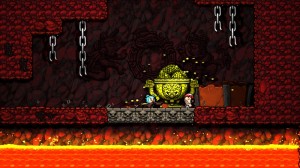Video game length can be one of the hardest aspects to nail down when it comes to fine tuning a game concept. It’s difficult to figure out just how long you can make a game with your given systems. Some titles feel too short, while others become a slog to play. For today’s post, I want to talk about a trend I see with Indie games and the use of “lunch break game design.”
A Quick Break
Lunch Break Game Design refers to titles built around a fast, but meaningful experience. Instead of spreading out gameplay over hours, these games tend to last anywhere from 15 to 45 minutes each play. The idea is that someone can get an entire play done while they’re waiting around, or have a limited time to spend playing.
This is the perfect format for games aimed at a casual audience, but we have seen other cases of it being used. The rogue-like and rogue-lite genres are perfect for lunch break game design. Because these games are meant to be replayed, condensing the design down helps to keep each play different.
When it comes to lunch break game design, there are three key criteria that go into it.
1: Short Plays
Lunch break game design is focused on short engagements. This is not something that will take hours to complete. On the other hand, games that are designed around a few minutes of play (or multiplayer matches) aren’t examples of lunch break game design which we’ll get to next.
This kind of design is perfect for games designed around a limited set of mechanics. Instead of trying to take something and stretch it out, you can condense it down into a shorter play for people with a few minutes to kill.
With that said, you still need to give them something of value, and that takes us to the next point.
2: A Complete Experience
Lunch Break Game Design is not about requiring the player to come back and play, but is instead built around a single playthrough in each sitting. The player must be able to complete a run of the game within the 15 to 45 minute window.
Short bursts of repeated play such as in multiplayer titles does not count, as they are inherently designed to require multiple plays in order to make progress. The key point is that someone can load this up during a break, and play through an entire playthrough of the title in the span of the break.
Any elements of persistence must not radically change the game or force someone to keep playing before “the real game begins.”
For the final point, we turn to the reason why someone will keep coming back to it.
3: Highly Replayable
The beauty of condensing game mechanics into bursts of play is that it presents a great environment to make a replayable title. If someone is only going to play your game for a single break, this opens up the door for random or procedural generated content to enhance the design.
The Infinite Space series is a great example; featuring different events and a procedural-built game space on each new game. This is why rogue-like design is a great match for lunch break game design, as the player doesn’t need to invest or lose a lot of time while playing a challenging game.
The beauty of lunch break game design is that it presents a title that essentially front-loads everything there is to the design. Someone is getting a complete game whether they play the game one time, or for multiple hours at 30 minute sprints.
With that said, there are a few limitations to this kind of design that we need to talk about.
A Light Meal:
Lunch Break game design is popular among casual fans, but for designers trying to make something for core or expert players, they are going to run into some problems.
This form of design will never be as complicated or as in depth compared to a larger game. There is only so much variety when your game is designed around single playthroughs. This goes back to the previous section: If you’re looking for something that you can really focus your attention on, this kind of design is not going to work for you.
The limitation also extends to the randomization/replayability. We talked about the different degrees or elements of random or procedural design before and how there are small and large variances. A small one is mainly window dressing or shuffles around existing elements. Large variances change what the player is going to be doing each time and impact the generation of the game space.
Games built on lunch break game design will usually focus on small variances, but there is an inherent limit on replayability.
Playing through games like Spelunky or Monster Slayers, there comes a point where you have seen everything that the game can possibly throw at you. Small variances are simply window dressing, and will not make each run feel different.
With all that put together, it’s important as the designer to go into designing a lunch break-styled game with the right expectations. Do not expect to sell a game like this for anywhere close to full retail pricing. If it’s taking you multiple years to finish a game like this, then something has gone wrong.
Short and Sweet:
Lunch Break Game Design is a good way to challenge yourself as a designer and avoid the risks of long-term game development. While it isn’t for every game, thinking in limitations is a great test and a way to see how well your mechanics can hold up in the short run.
For those of you reading this: Can you think of great examples of lunch break game design that delivered on a full experience?




